I tested one of the most stylish oil-filled radiators you can buy – it’s a game-changer for keeping my home warm and cosy
This oil-filled radiator combines a sleek, minimalist design with long-lasting warmth
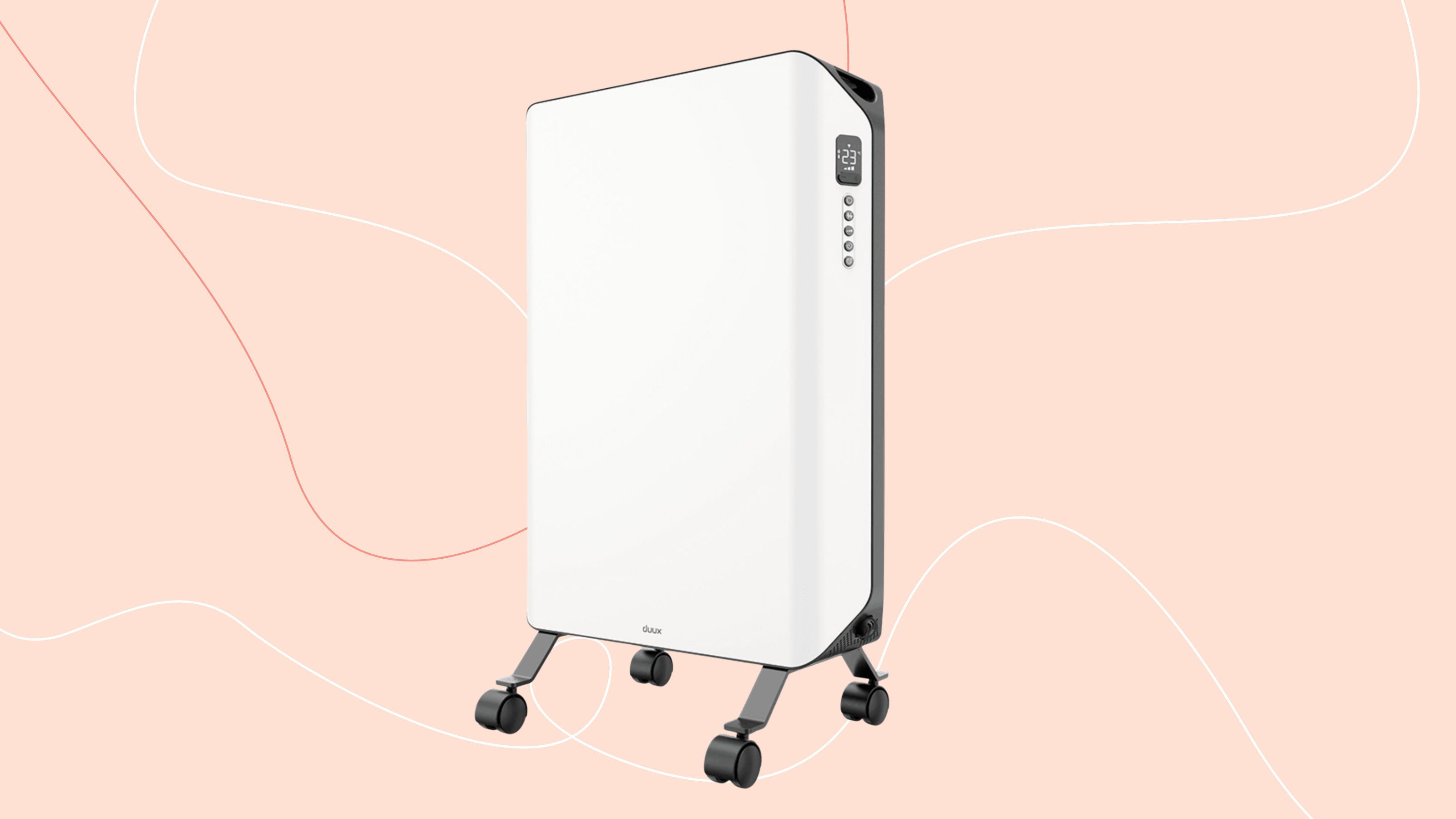
The Duux Edge 2000W Oil-Filled Radiator is stylish, quiet and impressively efficient. Its smart features make it easy to maintain a steady temperature, and it retains heat long after it's switched off, helping keep energy use down. Although it is an investment and the app setup can be tricky, it's a smart, energy-efficient heater that performs every bit as well as it looks.
-
+
Stylish and sleek design
-
+
Includes remote control and app connectivity
-
+
Maintains warmth after it's switched off
-
+
Includes 3 modes and 24 hour timer
-
+
Whisper-quiet operation
-
-
The app set up can be complex
-
-
It's expensive
-
-
Quite heavy so lifting upstairs is a struggle
Why you can trust Ideal Home

With the colder weather creeping in, I'm all about finding ways to stay warm without my energy bills soaring. So, I put the Duux Edge 2000W Oil-Filled Radiator to the test to see how well it heats a room, and whether its energy efficiency and ease of use live up to the hype.
After testing, I think the Duux Edge is a top contender among the best oil-filled radiators, and a standout choice for anyone looking for the best electric heaters this winter. This is everything you need to know.
In a nutshell
I'll admit, I didn't expect an oil-filled radiator to look this good. The Duux Edge 2000W Oil-Filled Radiator feels like a modern upgrade to a traditional model, and it's been a game-changer for keeping my home warm and cosy, without being an eyesore tucked away in the corner.
The design immediately won me over – it's sleek and minimalist, and it has a solid, premium feel to it. It's also practical, with the hidden castor wheels making it really easy to move between rooms, which I found ideal for warming up different areas of the house.
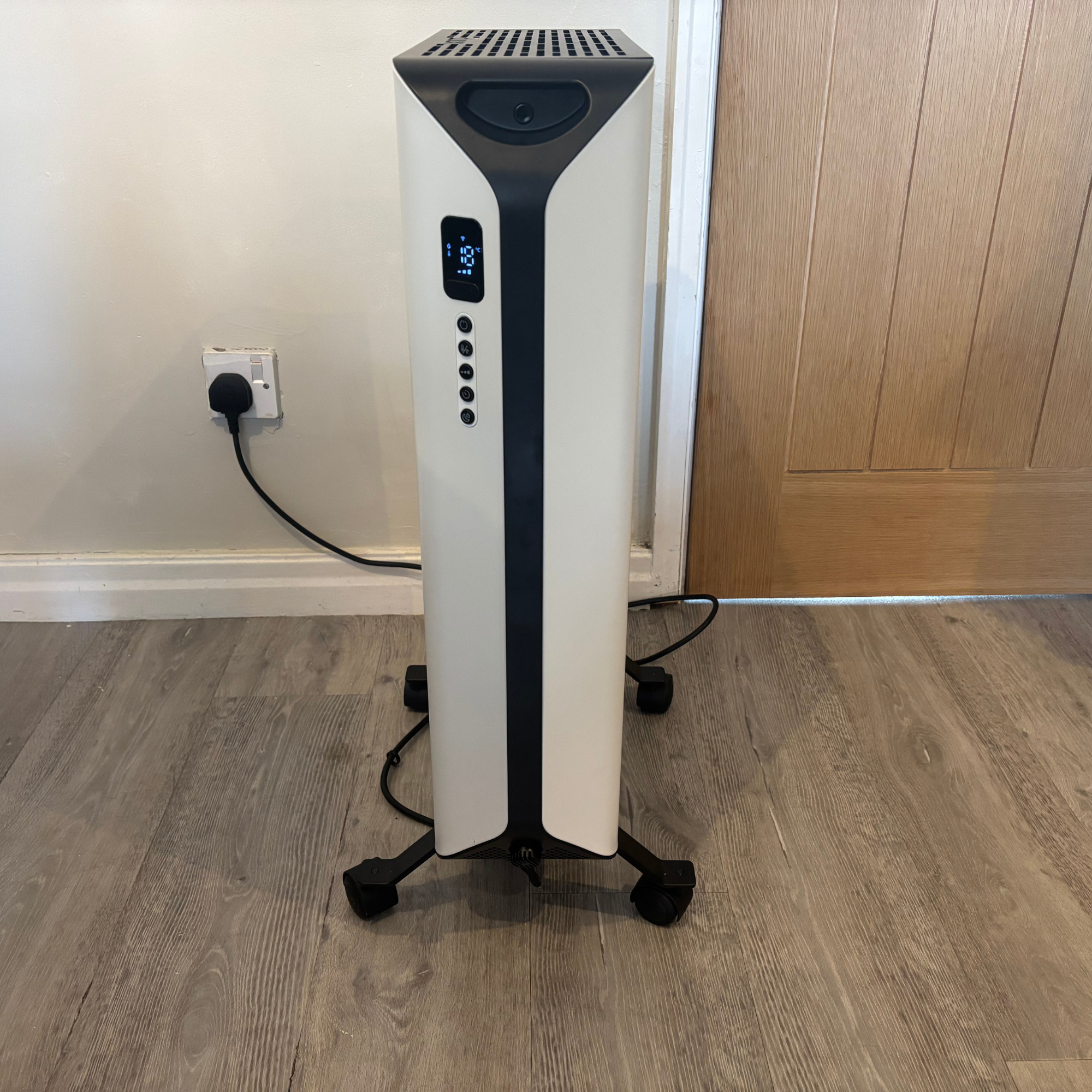
Performance-wise, it may take longer to heat up a room than a convector or fan heater. But once it does, the warmth feels steady and consistent. Impressively, it also retains heat for around an after being switched off – a definite win for energy efficiency.
I did experience some teething issues with the app setup, and found it to be a bit glitchy occasionally, but the radiator's features more than make up for it. These include three heating modes, a 24-hour time and a schedule function for added convenience. It is on the pricey side, but it looks and feels premium, and the design truly sets it apart.
How I tested

I'm Rebecca, and I write freelance content for Ideal Home. As a busy mum of three, I'm always on the lookout for home upgrades that make my home life smoother.
I tested the Duux Edge 2000W Oil-Filled Radiator in my family home for two weeks. I followed Ideal Home's dedicated testing process to compare the product to bestselling oil-filled radiators from other leading brands and see how well it performed against the best-in-class.
Specifications
- Type: Oil-filled radiator
- Power: 2000W
- Dimensions: 46 x 32 x 71cm (incl. feet and wheels)
- Weight: 15.3 kg
- WiFi connectivity: Yes
- Timer: 1-24 hrs
- Safety switch: Yes
- Extra features: Child lock, tip-over switch, overheating protection
- Price: £249
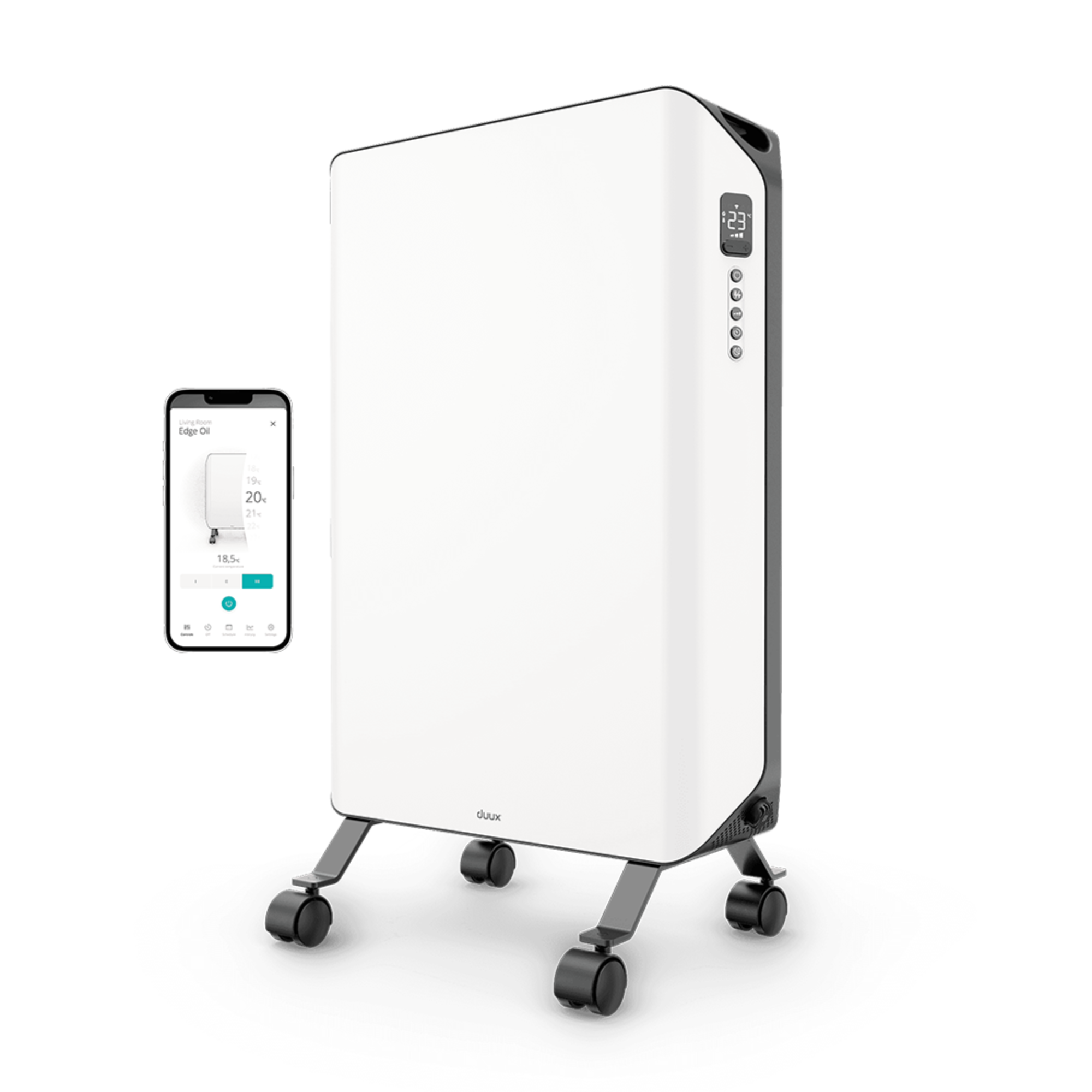
Unboxing and setting up
The Duux Edge Oil Filled Radiator 2000W arrived in a large, rectangular, branded cardboard box. It was very heavy too, but with a weight of 15.3kg, I wasn't expecting it to be lightweight. The box had carry handles on either side, which made it easier to manoeuvre, but I wasn't able to lift it myself. So, just bear in mind, as you need a helping hand, too.
Sign up to our newsletter for style inspiration, real homes, project and garden advice and shopping know-how
Inside the box, the radiator was well protected by moulded cardboard packaging, with the parts and accessories neatly slotted into the grooves. Beneath the top layer was another sheet of cardboard for extra protection, and the radiator itself was wrapped in 100% compostable packaging.
I usually expect to find some non-recyclable materials, so discovering that everything was fully recyclable was a pleasant surprise and created a really positive first impression.
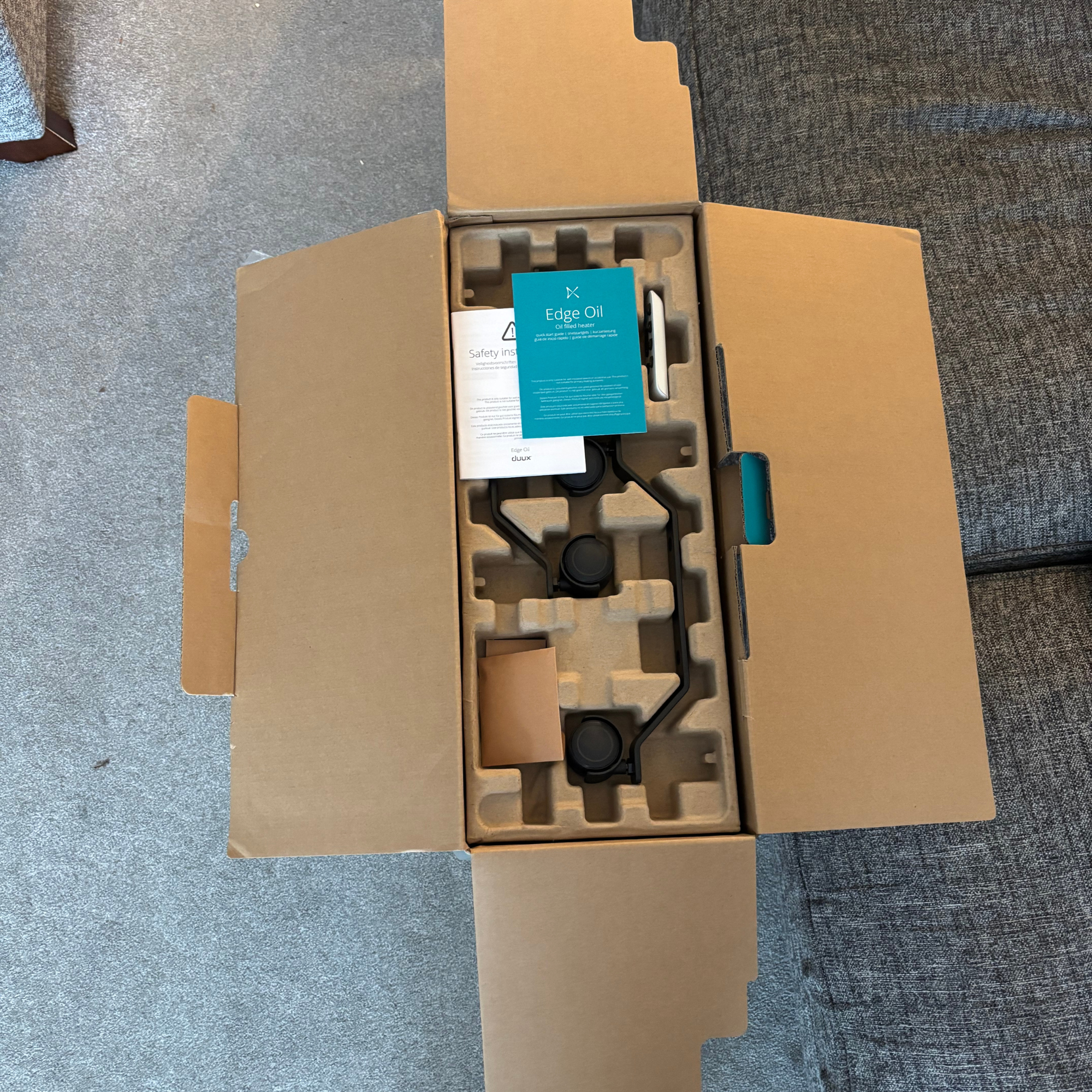
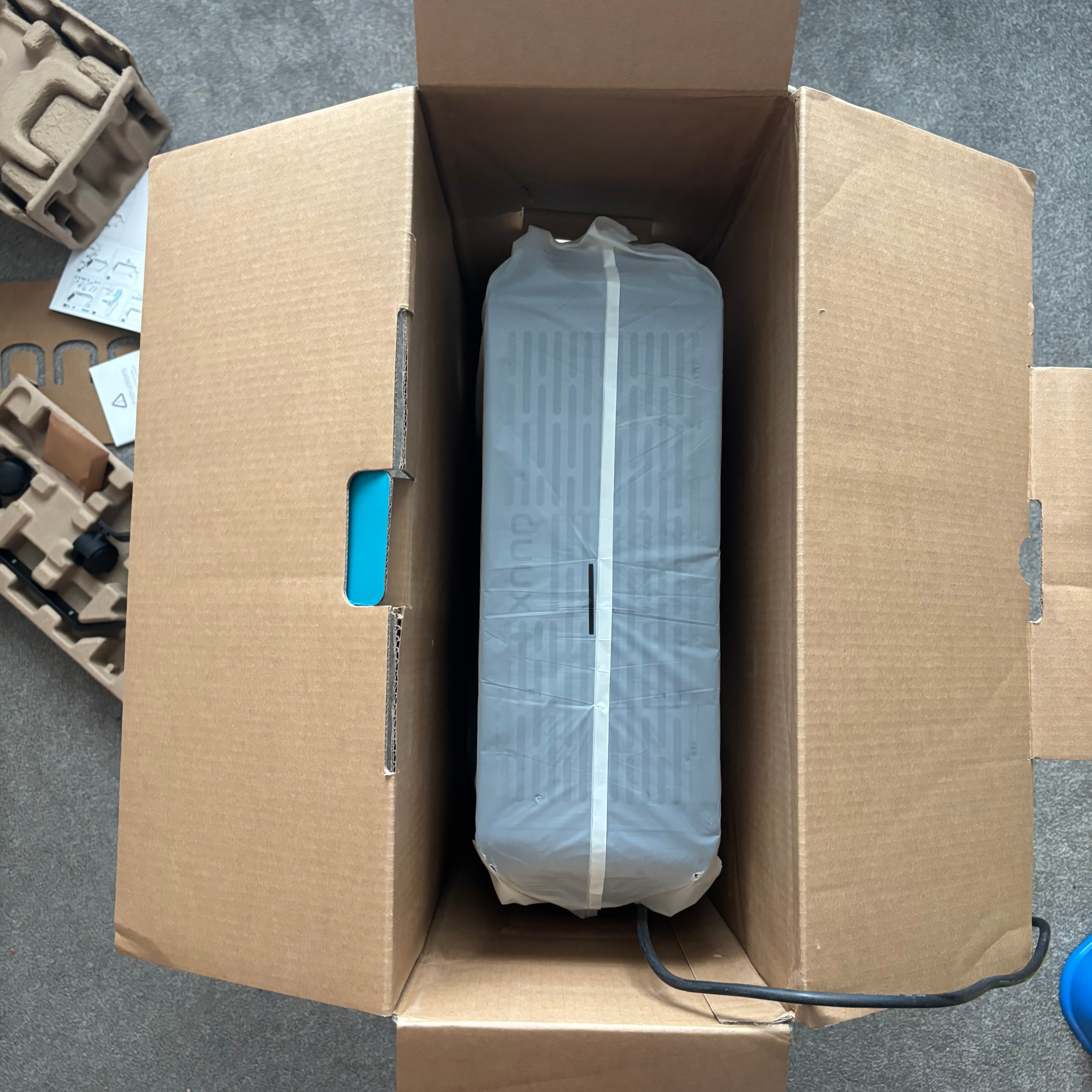
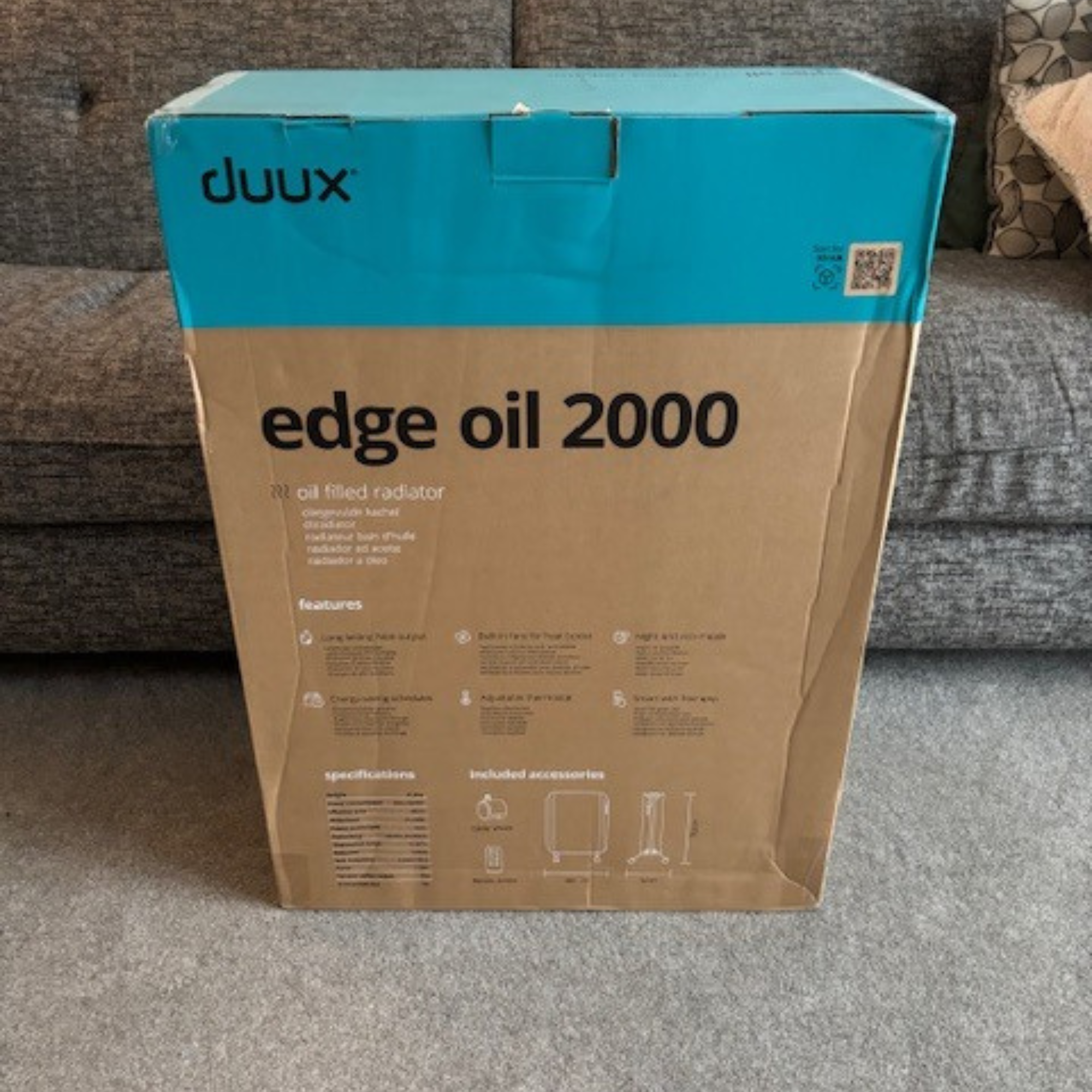
I unwrapped everything and laid out all the contents, which included the radiator itself, an instruction manual, a remote control with a battery, two steel feet with wheels, plus screws, an Allen key and a mini spanner.
I must admit that when I first opened the box and realised there was some assembly required, I felt a bit daunted, as I'm not exactly known for my DIY skills. However, I needn't have worried, as putting it together was incredibly simple.
I turned the heater upside down (at which point I could hear the oil trickling inside) and lined up the steel legs to the screw points at either end of the base. Using the supplied Allen key to fix them in place, I had both sides attached in under two minutes.
I also had to pop the battery into the remote, which was a little more fiddly as it was small, but still straightforward enough. Once it was all set up, I plugged the oil-filled radiator into power, at which point it let out a small 'beep' and the LED panel displayed the power button. I used the remote to cycle through the different modes, including dialling the temperature up and down.
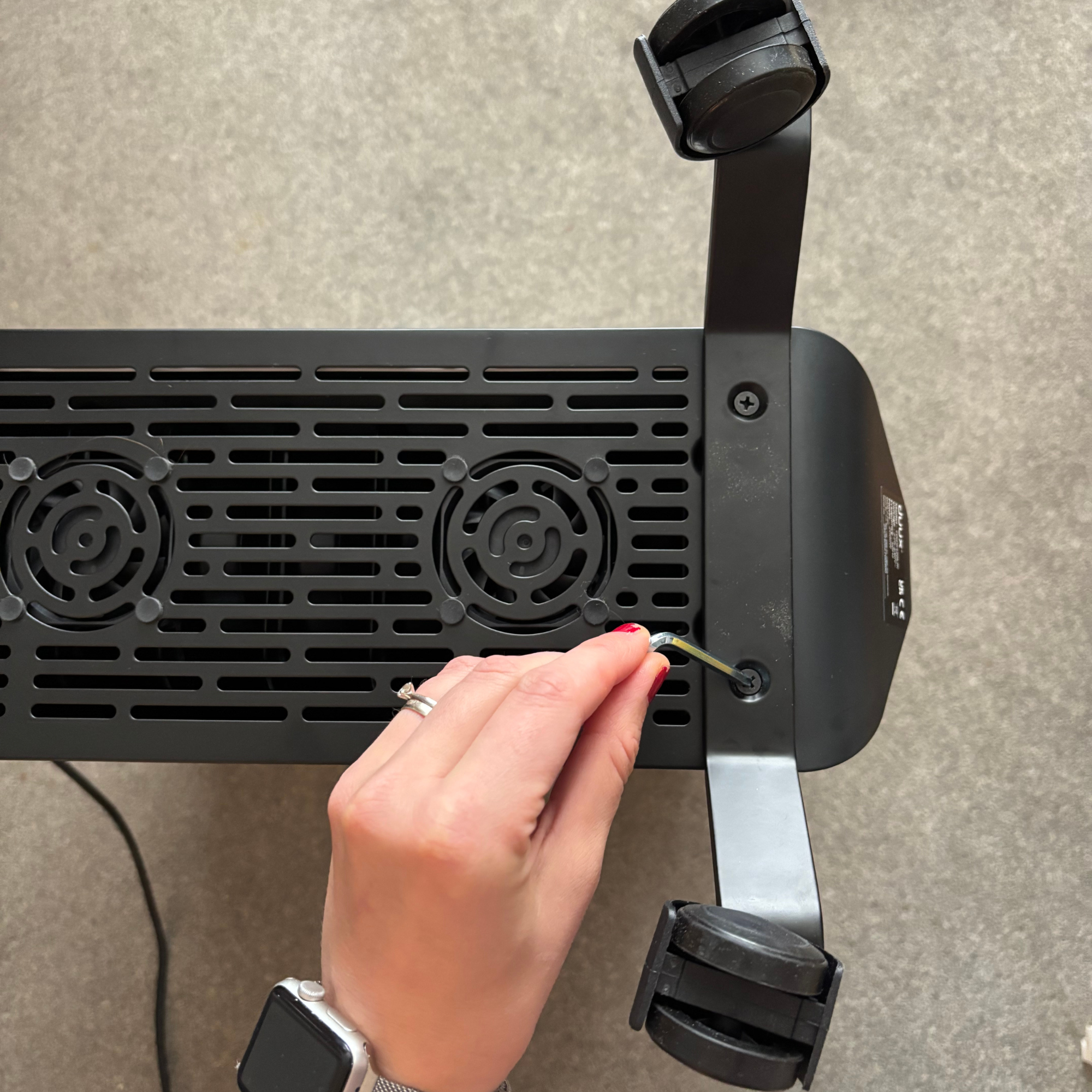
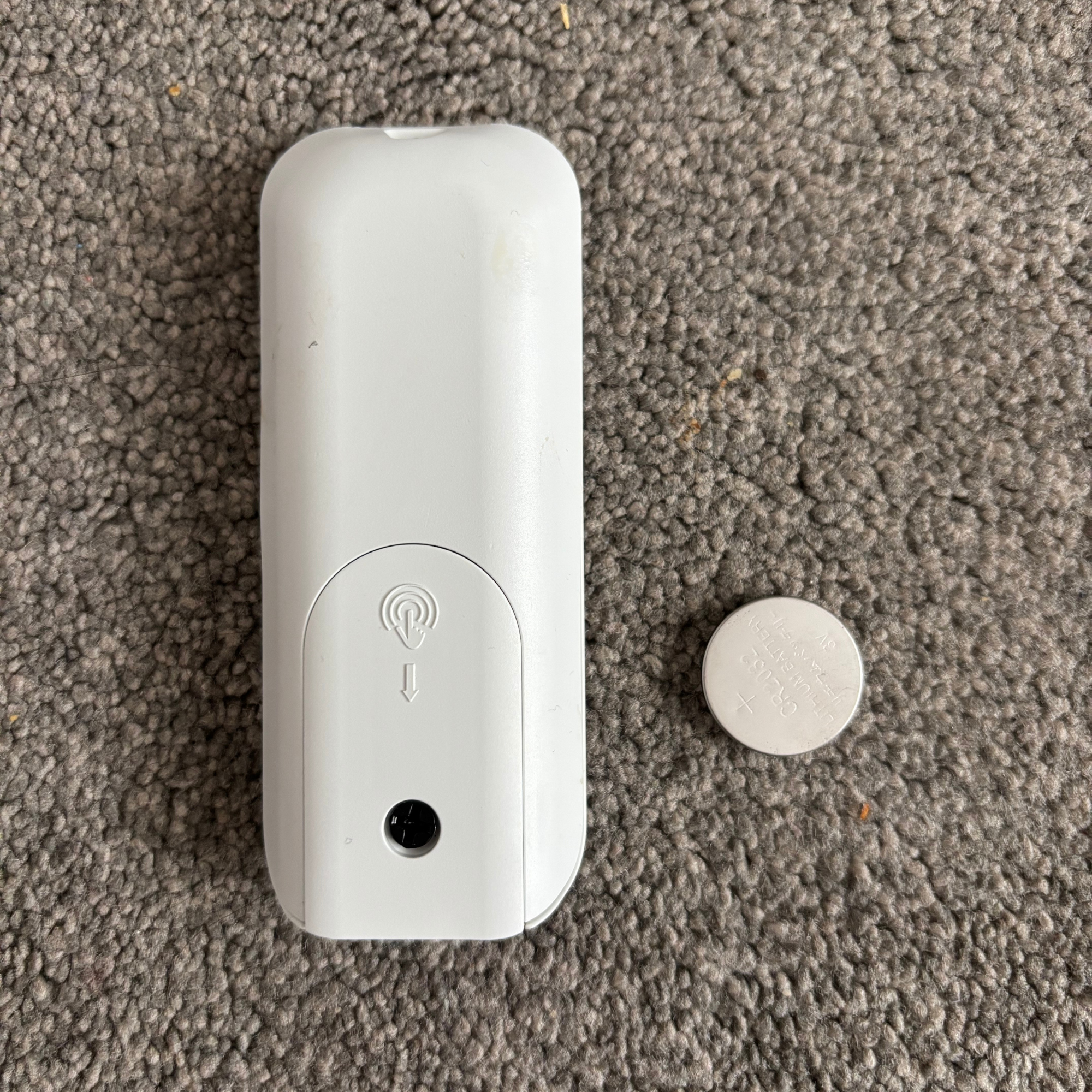
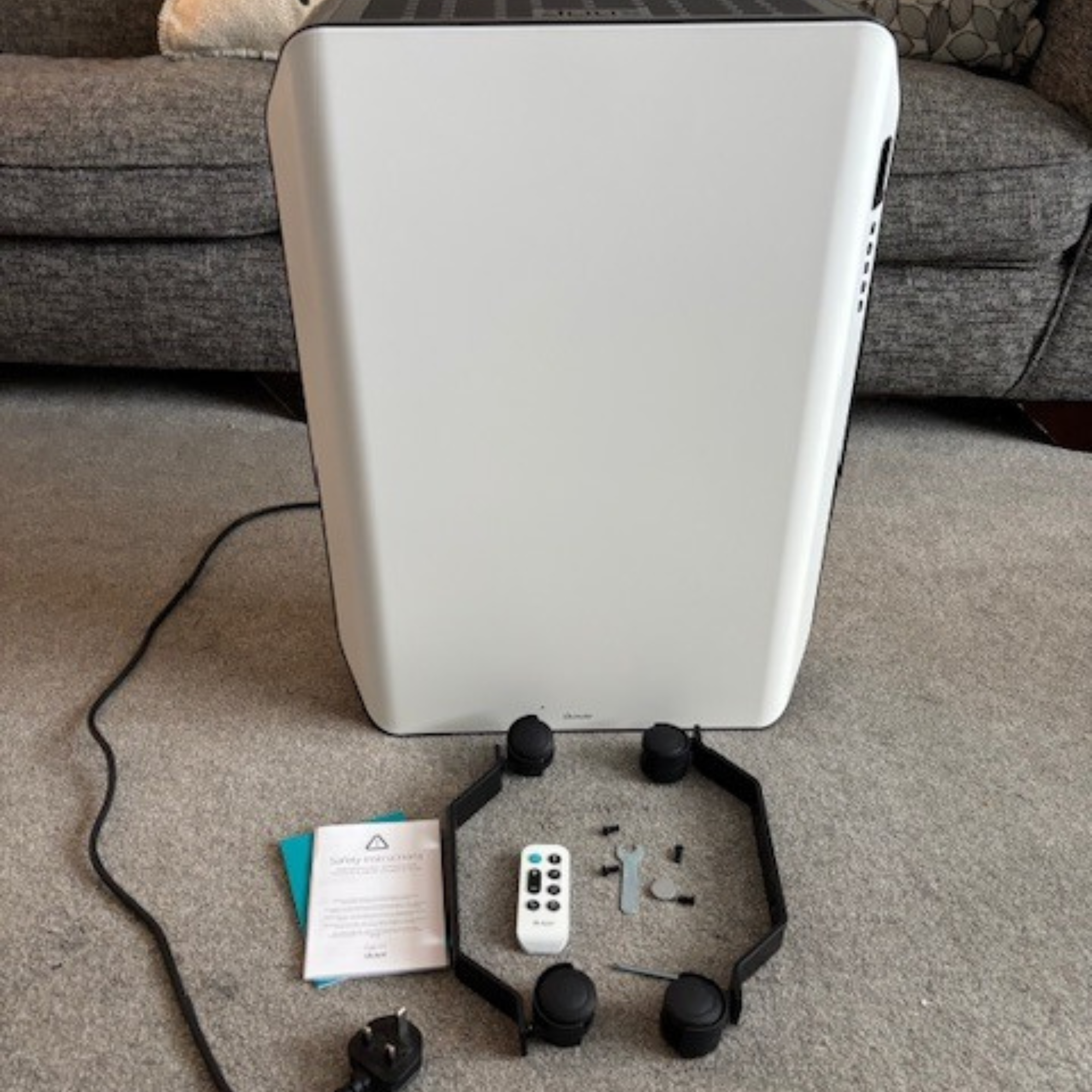
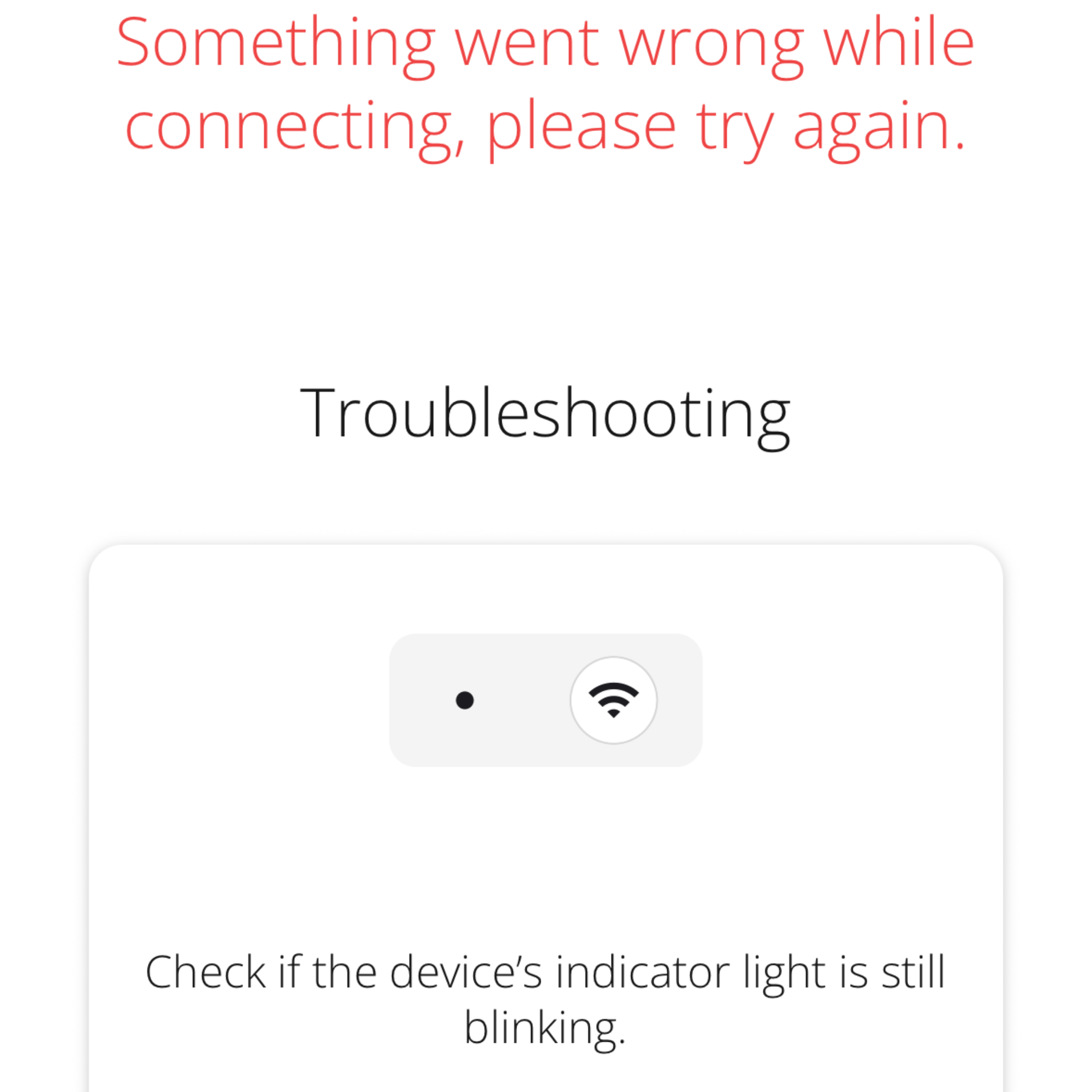
Although a remote is included, the oil-filled radiator can also be controlled through a smart device using the Duux app, so I was keen to get this set up. I scanned the QR code, downloaded the app and created an account using my email address. I then tapped the + symbol in the top-right corner of the app to add a device, then scrolled through the list to select the Duux Edge 2000W Oil-Filled Radiator.
I made sure the radiator was in pairing mode by pressing and holding the WiFi button on the side panel for about five seconds until it started flashing continuously. The app prompted me to enter my WiFi password and tap Connect. After roughly 30 seconds, this connection error message appeared: 'something went wrong while connecting, please try again'. Below the message was a troubleshooting guide suggesting I check whether the device's indicator light is still blinking and that the Wi-Fi password I entered was correct.
After a couple more attempts and some digging on the Duux website, I discovered that my smartphone must be set to the 2.4 GHz Wi-Fi band, not the 5 GHz band, for the heater to connect. I also found that other users had experienced this issue with the Duux app.
So, I disabled the 5Ghz band in my router settings, which was a bit of a faff. But once I'd done this and repeated the setup steps, the device successfully connected, and I was ready to go.
Design
Although I own a portable electric heater, I've never found it particularly attractive, as it's always been about practicality above all else. So, when I first opened the Duux Edge 2000W Oil-Filled Radiator, I was instantly impressed by its sleek, minimalist design, which will easily blend into any modern space.
Unlike many traditional oil-filled radiators, it doesn't have multiple metal fins; instead, it features a flat, enclosed panel design. Besides being very nice to look at, it's also more practical – there are no sharp edges or hot fins to worry about, which makes life so much easier for me with young children. It's compact too, which works well in my home where space is limited.
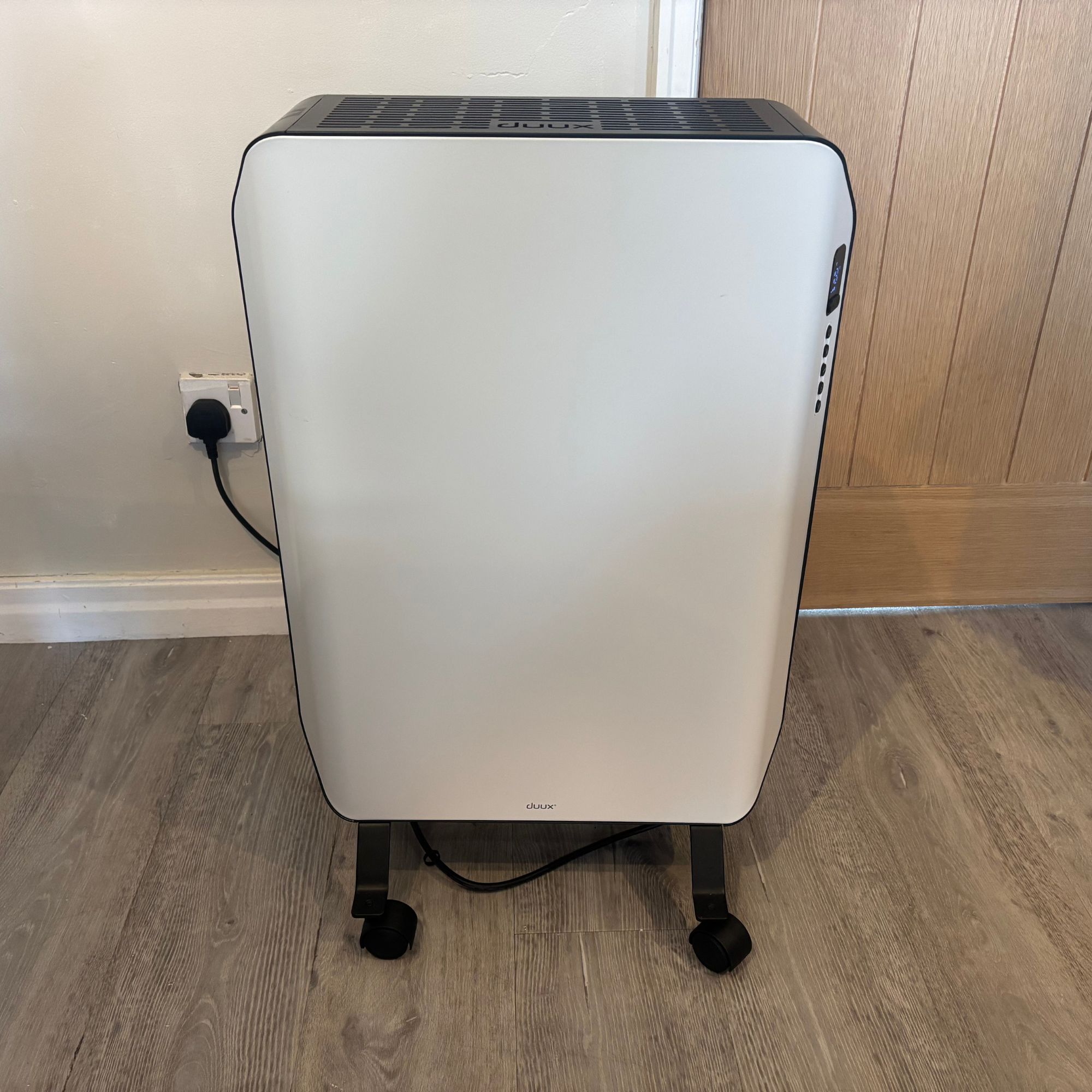
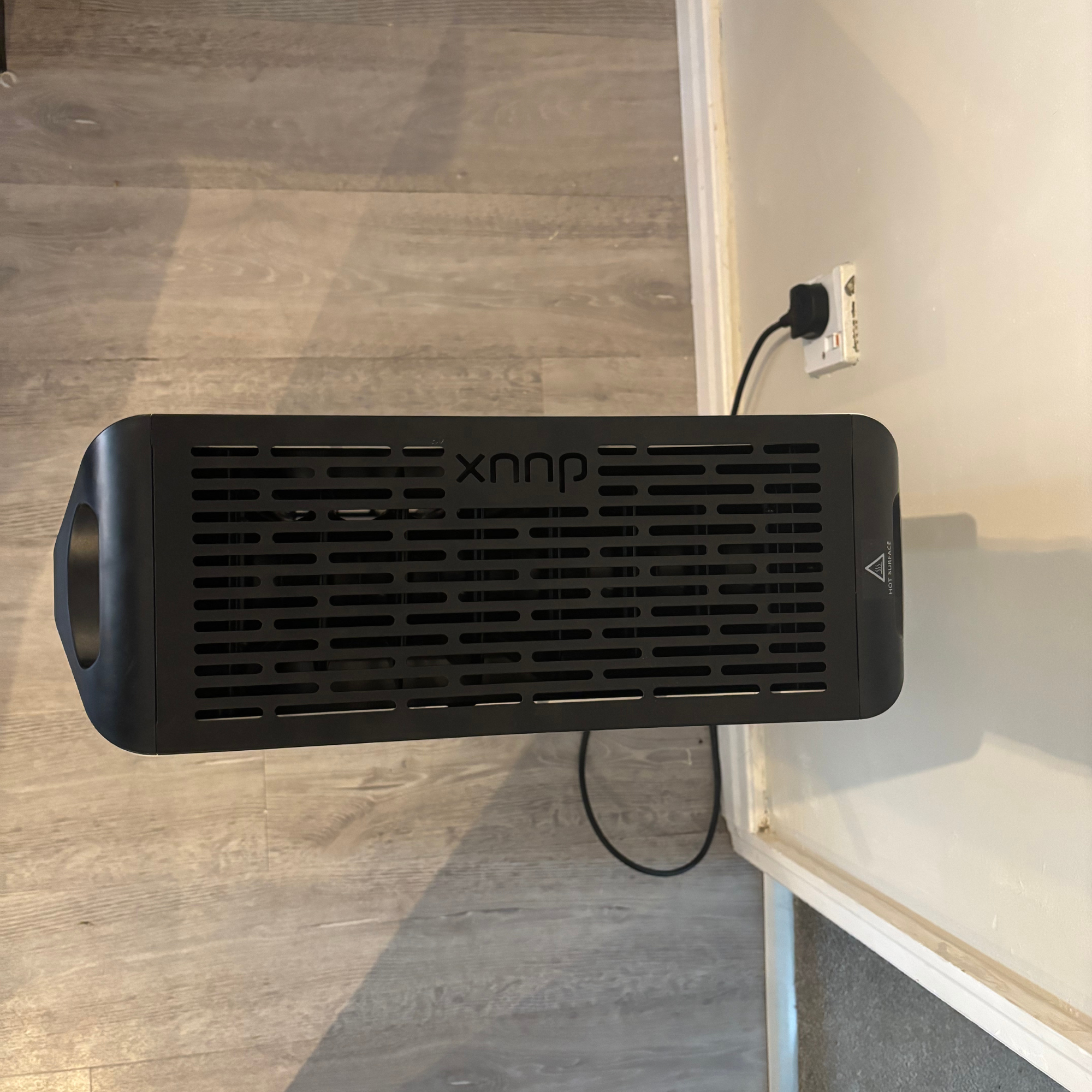
The LED display panel sits discreetly on the side of the radiator, plus the remote control makes it really easy to navigate the settings. It also has a night mode that dims the display and mutes the sound for undisturbed sleep. While it's not the lightest radiator, the combination of wheels and handles makes it manageable to move from room to room. Although admittedly, lifting it upstairs does require a bit more muscle!
My only other niggle is the cable length – at 1.6m it's not particularly short compared to other oil-filled radiators, but I do think it might restrict the positioning in some large rooms. Still, that's a minor inconvenience in an otherwise very well-designed heater.
Ease of use
The Duux Edge 2000W Oil-Filled Radiator is incredibly simple to use once it's set up, offering a good mix of smart features and manual controls. The remote control and LED display panel make it easy to adjust the temperature, switch between the heating modes, and set timers.
As mentioned, I found the app setup a bit tricky, and it glitched when my internet cut out - logging me out and causing the device to disappear completely from the app. I did have a minor panic that the data was lost; however, it was soon restored without needing to re-pair. Still, it made me question the software's reliability.
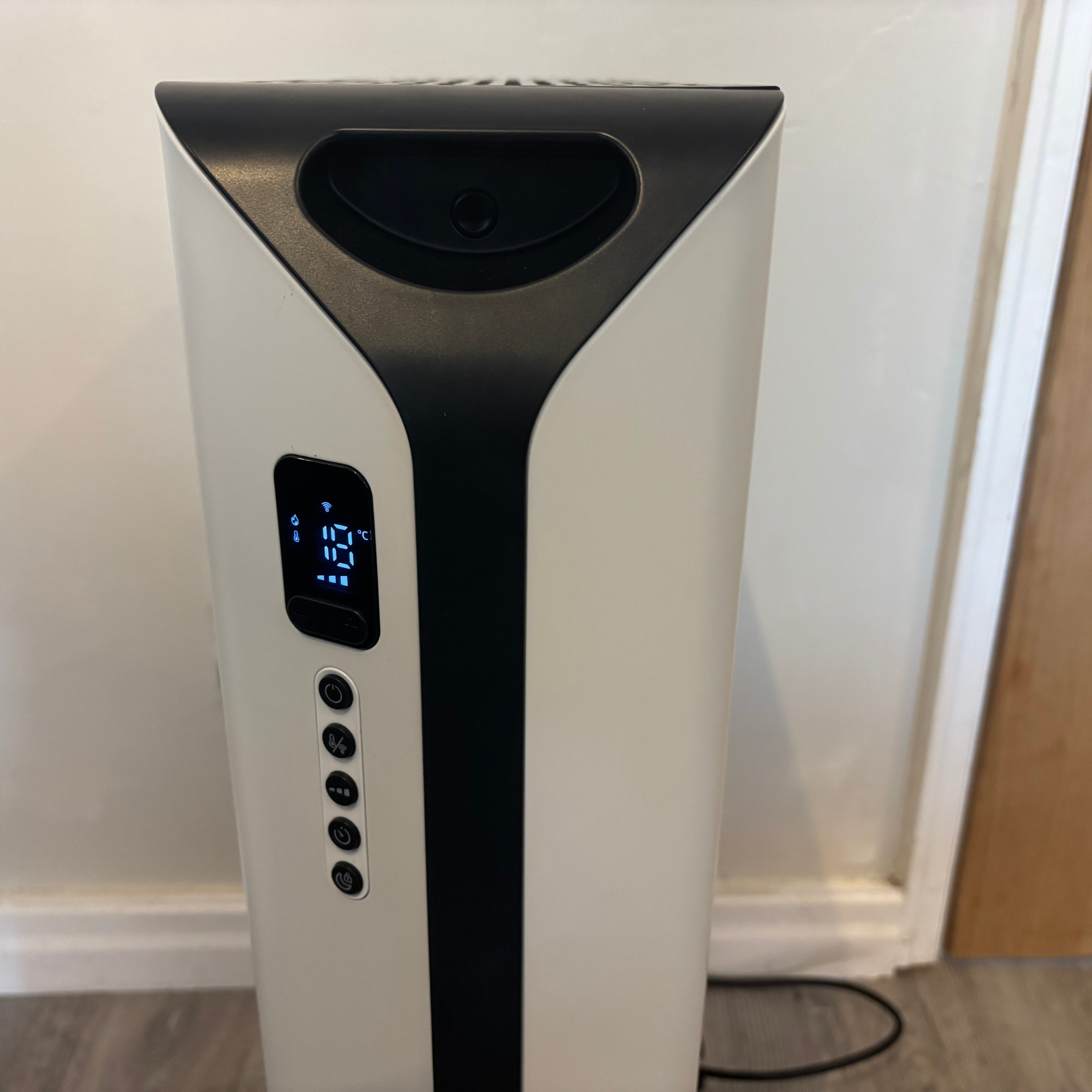
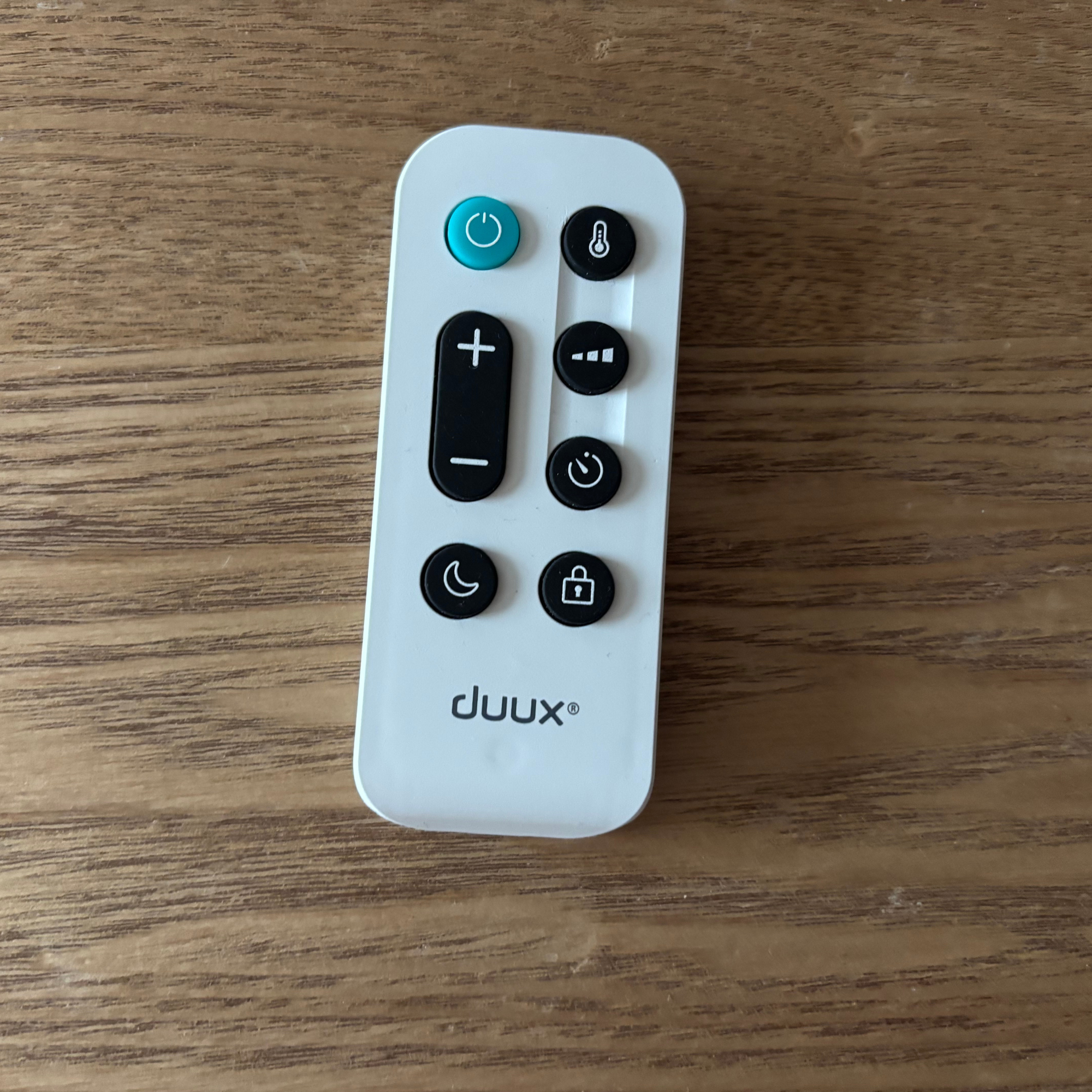
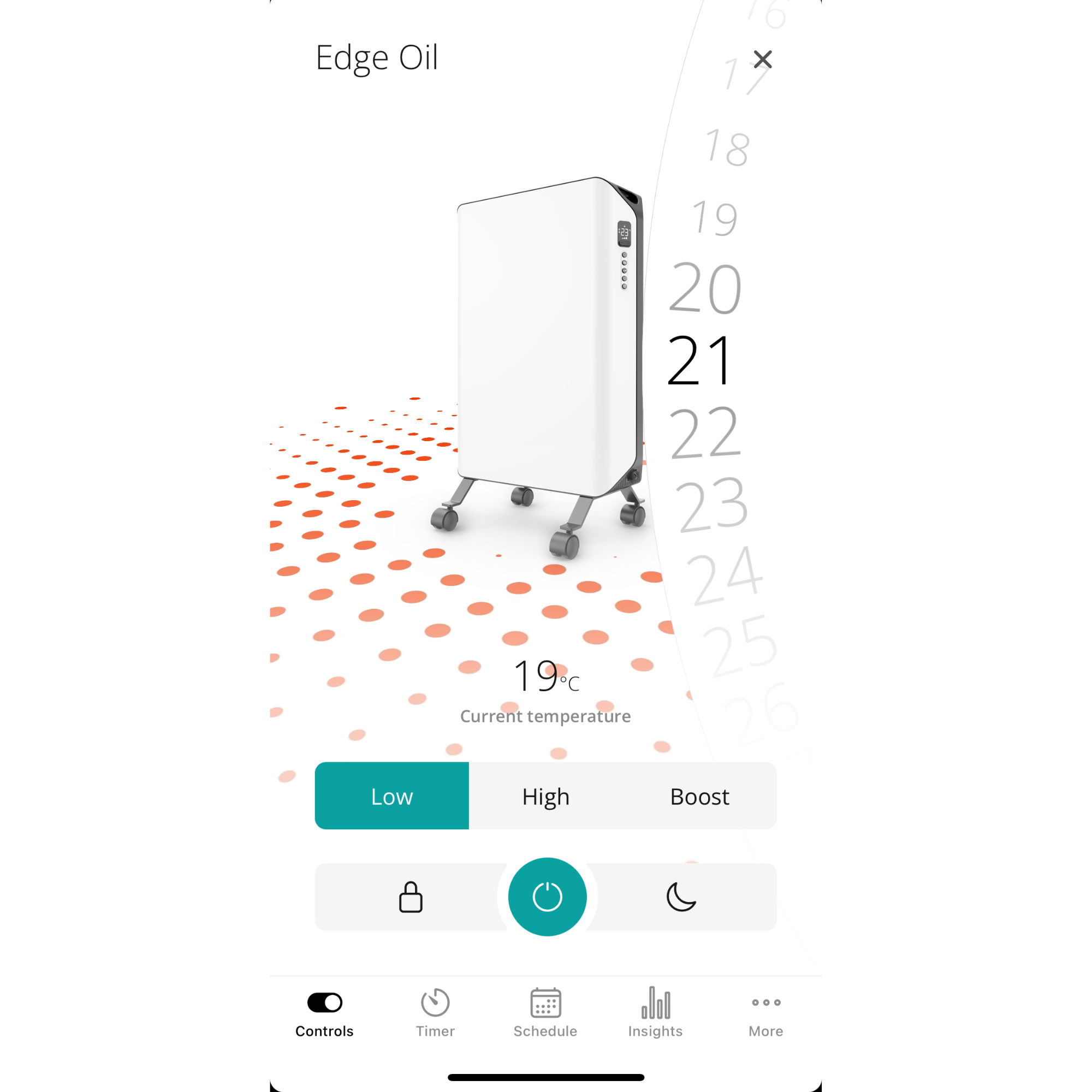
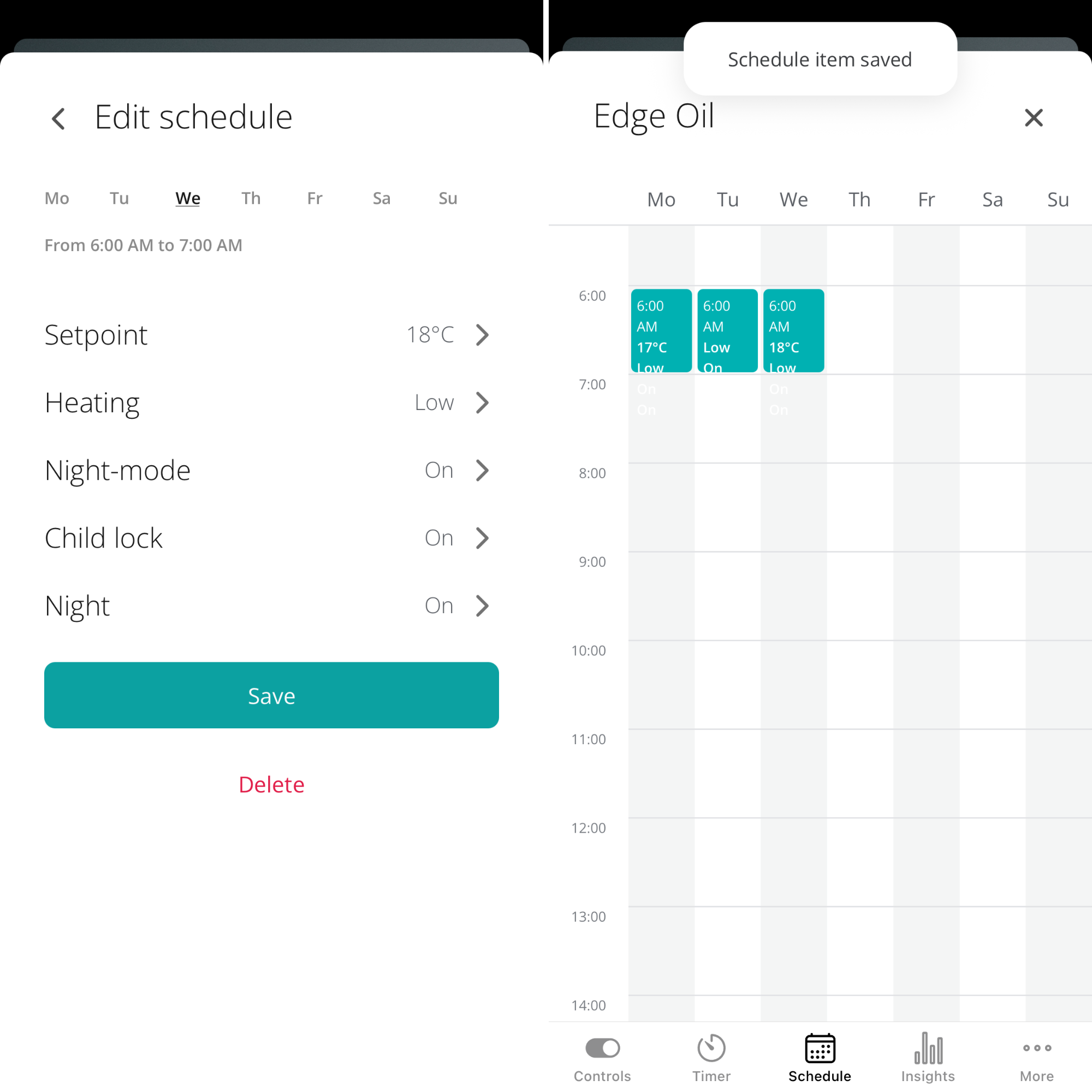
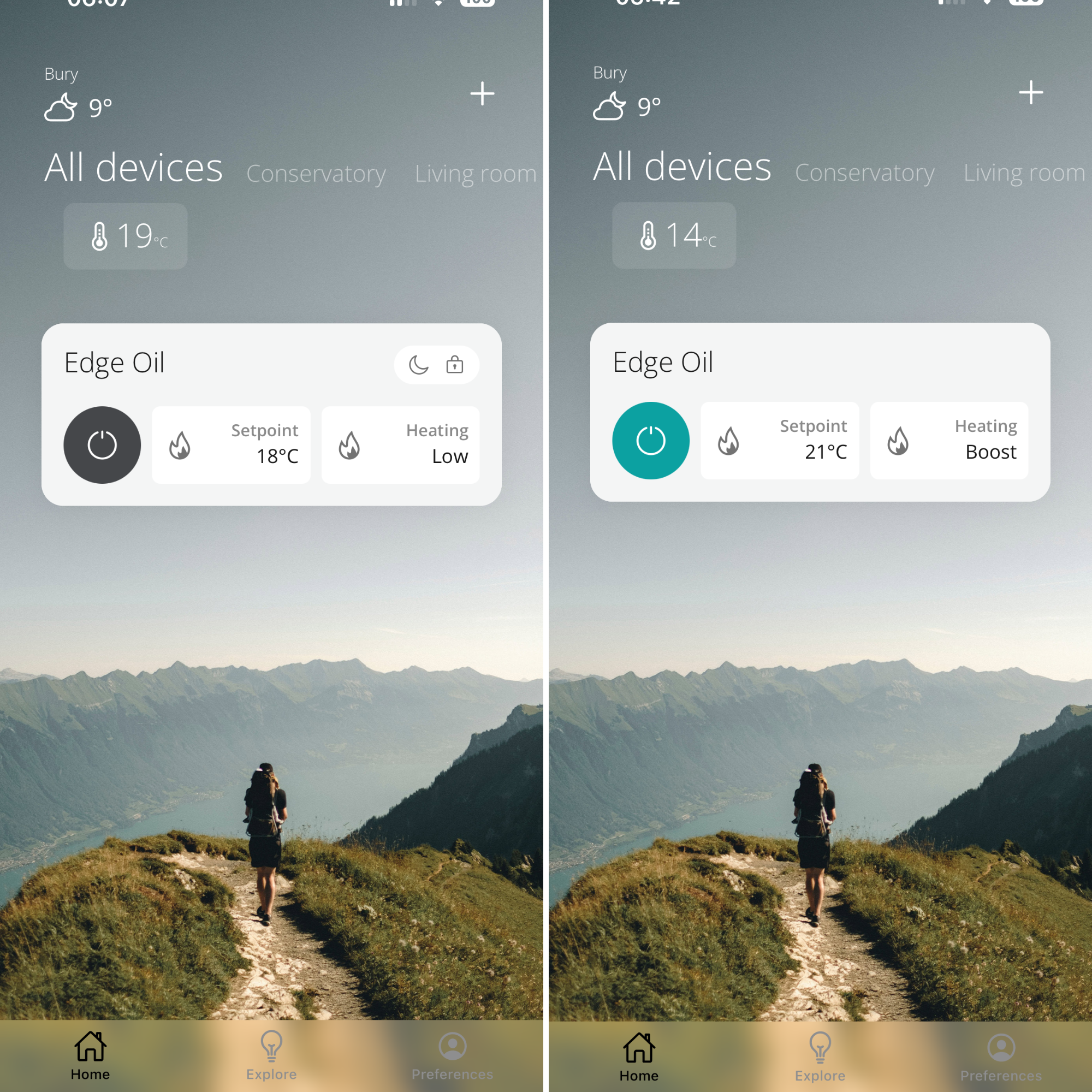
That said, the app itself is really straightforward to use once connected. You can turn the radiator on or off with the tap of the power button, and select one of the three heating modes directly from the home screen. And you don't need to rely on the app day to day; the physical controls are intuitive, and the night mode, which dims the display and mutes sounds, is a useful feature for undisturbed sleep.
It also has a child lock feature, accessible via the buttons on the LED display, the remote, or the app. With a very curious toddler in the house, I found this feature reassuring and made a point to switch it on whenever the kids were nearby.
The Duux app also provides more detailed insights and lets you create heating schedules – ideal if you want to control the radiator remotely or preheat a room before you get home (or first thing in the morning). This was really easy to do, and I tended to set the timer to come on at 6 am for one hour on Low mode, and again in the evening when the temperature dropped.
Performance
I tested the Duux Edge 2000W Oil-Filled Radiator at the start of autumn, when the temperature had started to drop, but it wasn't quite cold enough to turn the central heating on. Working from home (and as someone who easily feels the cold!) provided the perfect testing ground.
It's designed for rooms up to 30m², so I decided to test it in my kitchen and open-plan conservatory first, as this tends to be the coldest part of the house (and it's also where I usually work). After switching on the power button, I could feel the heat almost instantly radiating from the top vent, and within a couple of minutes, it was too hot to touch.
I set the temperature to increase by two degrees, and according to the insights graph on the app, it took just over an hour to rise from 15°C to just over 20°C, with the temperature set to 'High'.
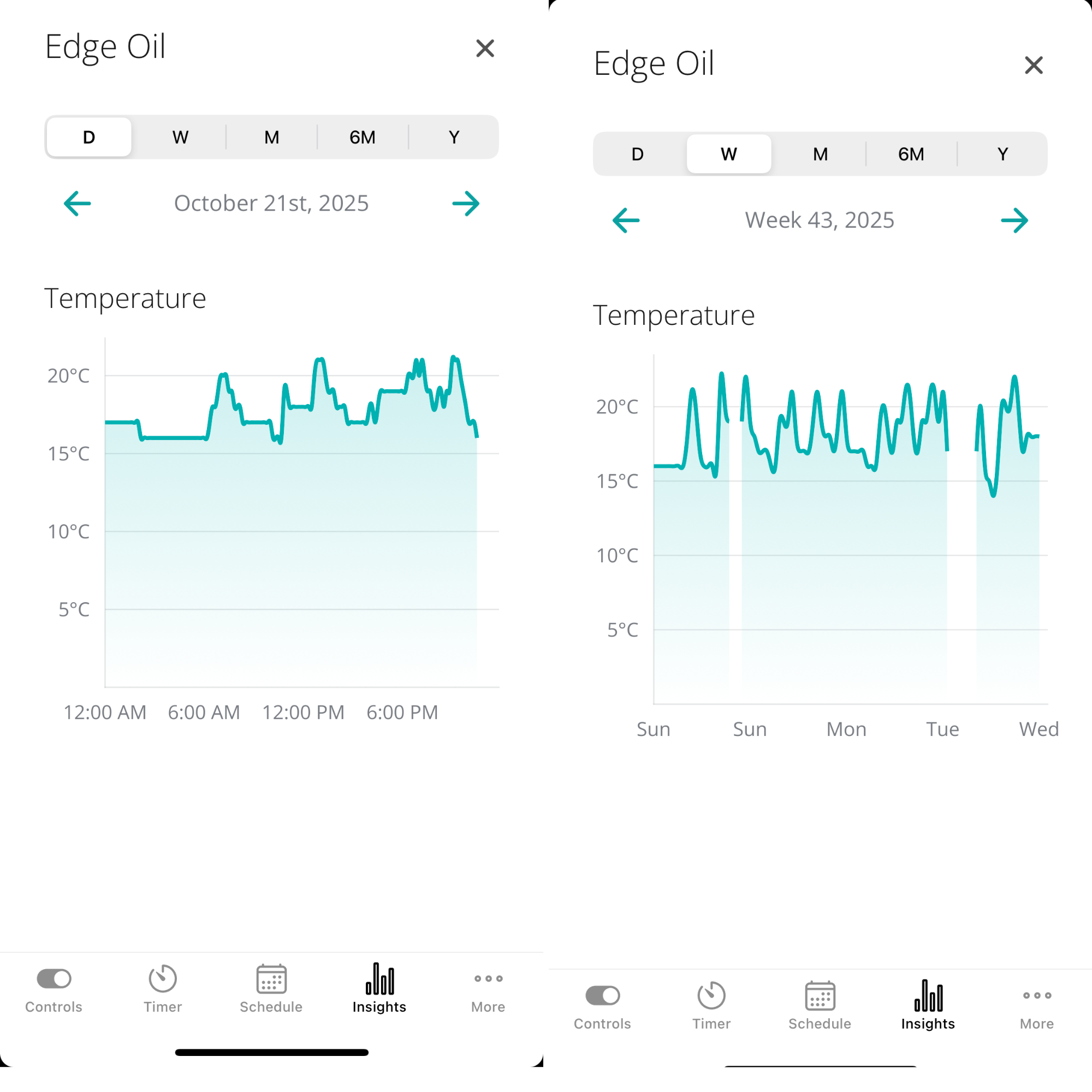
Rather than cutting out immediately, the radiator cleverly waits until the temperature moves slightly above or below the set point before adjusting – a smart, energy-saving feature that keeps the room at a stable, comfortable temperature. I could see from the app's insight graph that it maintained a steady level of warmth throughout the week, with only minor fluctuations as it was turned on and off.
After switching off, the room temperature gradually dropped over about an hour, but it still felt noticeably warmer than in other areas of the house.
Another handy safety feature is its built-in overheat protection, so the radiator will turn off if it gets too hot or is knocked over (which, touch-wood, hasn't happened as yet, but it's entirely possible in my house).
After the initial test, I experimented by using it in other rooms of the house, including my bedroom, in the evening when the temperature was only 14°C. When using Boost mode, it only took around 15 minutes to reach 17°C.
Overall, it delivers consistent, efficient heating performance and does a great job of keeping the room warm – so much so that it's already earned a permanent spot in my home this winter.
Energy use
How much it costs to run an oil-filled radiator depends on a couple of things - its wattage and the current price of electricity. I'll admit, I was a little sceptical about the cost to run the Duux Edge 2000W, given its higher wattage.
And based on my electricity tariff of 22.71p per kWh, it cost me around 45p per hour to run at full power. That said, once the room reached a comfortable temperature – which took about an hour – I switched it to Low mode. This runs at roughly half power (around 1000W), and the cost drops to roughly 10-15p per hour.
One of the standout features for me is how well it retains heat. The radiator continues to give off warmth for an hour after being switched off, meaning I didn't need to turn the central heating on and I got to enjoy some free, extra warmth – a big win for energy efficiency.
Also, when I'm working from home, there is no real need to heat the entire house, so having the option to heat only the room I'm in is the perfect solution.
At the time of writing, it's too soon to say whether it's reduced my energy consumption, as I haven't had an electricity bill. However, I've not switched my central heating on since I've been testing the oil-filled radiator, so I'm confident I'll notice a difference.
Noise levels
One thing that really stood out during testing was how impressively quiet the Duux Edge 2000W Oil-Filled Radiator is. Unlike some oil-filled radiators that can make clicking or gurgling sounds as they heat up, this one operates almost silently, so it's perfect to use in bedrooms or home offices.
Even in Boost mode, the radiator runs at around 40 dB – about as quiet as gentle rain – so it doesn't disturb work or sleep (though you'd be unlikely to use this mode overnight). Overall, it earns top marks for noise levels.
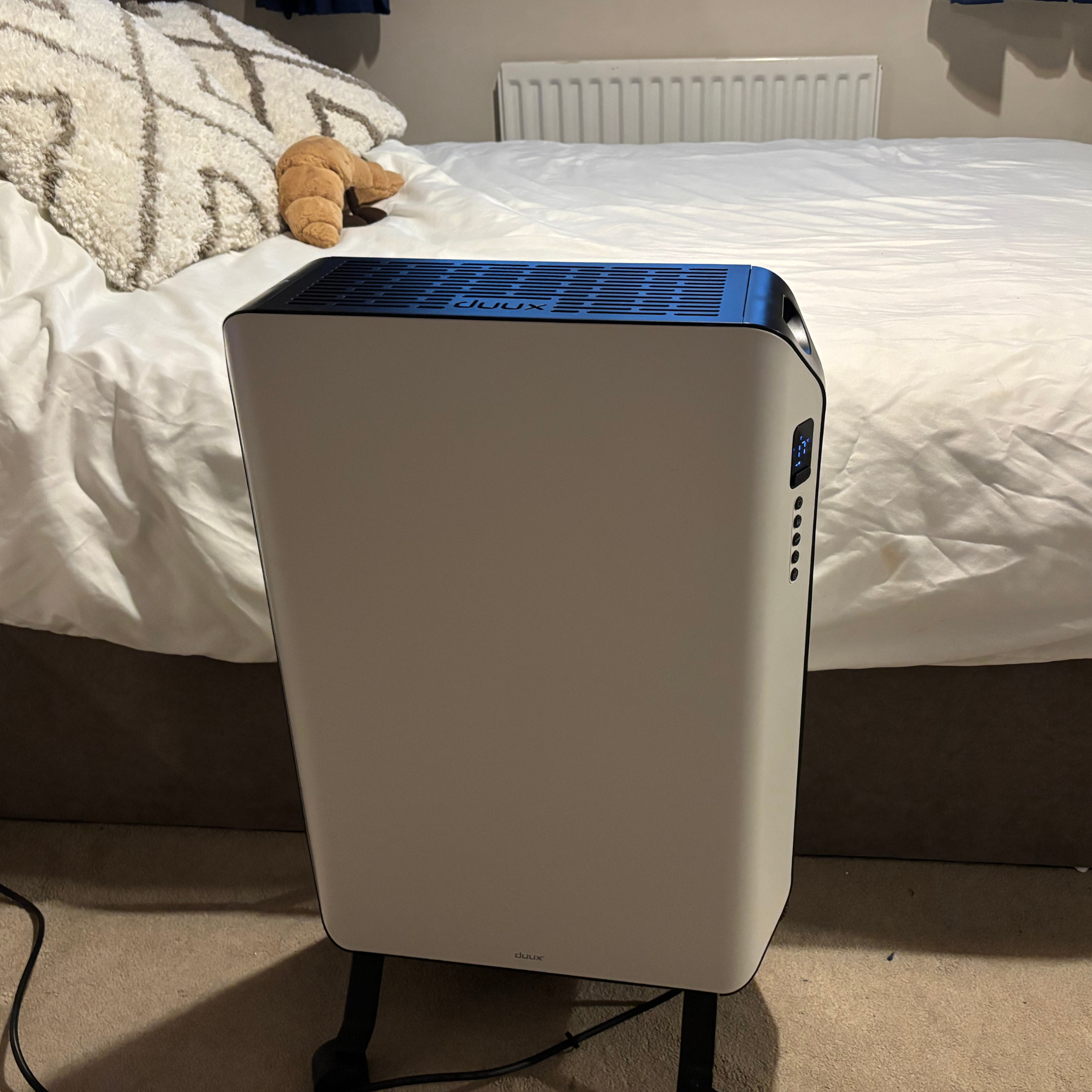
How does it rate online?
Despite being on the market for over a year, I struggled to find many reviews of the Duux Edge 2000W Oil-Filled Radiator, despite extensive searching across multiple retailer and review sites. This could suggest it hasn't been purchased many times yet. While there weren't any reviews on the Duux UK website, I found two five star reviews on the EU version. Customers were impressed with how quickly it heated the room, with one user describing the design as 'beautiful'.
On Amazon, the product is listed as having 4.1 stars, but after reading the individual reviews, it became clear that they are all for the 1500W model, which you can buy on Amazon for a slightly cheaper price of £198.95.
That said, feedback from the 1500W, combined with the specifications and features for the 2000W model, suggests they share similar strengths – efficient heating, quiet operation and the convenience of the smart app control.
How does it compare to similar models?
The Duux Edge 2000W Oil-Filled Radiator builds on the brand's 1500W model, sharing the same slim, minimalist design but delivering a higher heat output. Although it comes with a steeper price tag, the 2000W version is generally more energy-efficient in larger spaces, so it does offer better value for money, since the 1500W may need to run for longer or at a higher setting to reach the same temperature.
If you're looking for a wall-mounted heater that heats up more quickly, the Duux Edge 2000 Smart Convector Heater might be a better fit – it uses convection technology rather than oil, so it delivers faster heat, but it doesn't retain it as long.
There are several comparable models worth considering, including the Pro Breeze 2500W Oil-Filled Radiator, which topped Ideal Home's pick of the best oil-filled radiators. The Dunelm 2000W Contemporary Round 9 Fin Oil Filled Radiator and the VonHaus 11 Fin 2500W Oil Filled Radiator are more budget-friendly alternatives, though neither offers the same sleek design or advanced smart functionality as the Duux Edge.
Verdict: Should you buy the Duux Edge 2000W Oil-Filled Radiator?
If you're looking to invest in an oil-filled radiator this winter - that's not only practical but stylish enough to proudly display - you'll be hard pressed to find a better option than the Duux Edge 2000W Oil-Filled Radiator.
Granted, it comes with a premium price tag compared to most oil-filled radiators, but it makes up for it in performance and design. While it heats up quickly, it's worth noting that the top vent gets very hot, so you'll need to be extra cautious if it's within reach of young children. That said, the child safety lock and overheat protection do provide peace of mind.
I think it's a solid choice when you don't want to blast the central heating, as it will warm a room quickly, and retain heat, keeping you warm without wasting energy.
